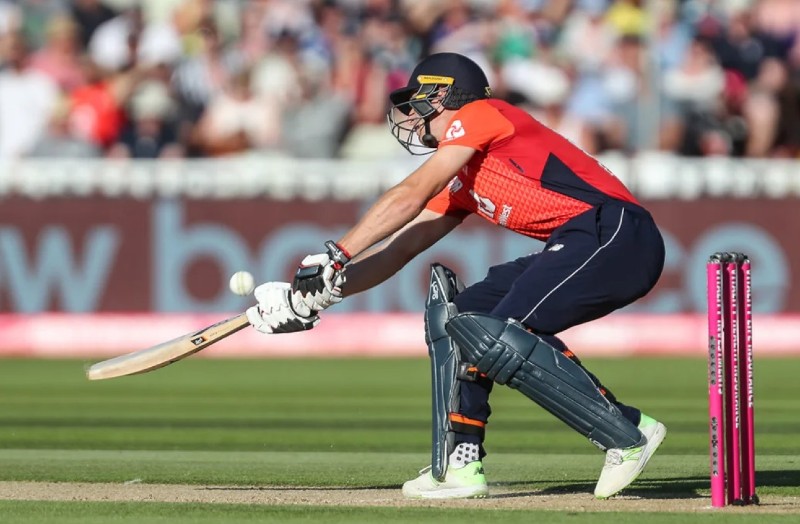How To Play The Unorthodox Ramp Shot In Cricket? (Detailed Guide)
Cricket is a game that has evolved over time, with new shots being invented and added to the game. One such shot is the ramp shot, which has become increasingly popular in recent years. But do you know how to play the ramp shot?
The ramp shot needs accuracy and precision as batsmen try to hit the ball over the wicketkeeper. It is also a very difficult shot to master. If any batsmen miss a ramp shot or have an edge, it can be a wicket for the bowling side.
Although the ramp shot is not as popular as the cover drive or the hook shot, good batsmen often use this shot, especially against spinners. So now, we will analyze this shot and also try to know how to play the Ramp shot with perfection.
What Is A Ramp Shot?
A ramp shot is a shot played by a batsman in which they lift the ball over the wicketkeeper’s head or the slips using a flick of their wrists.
The shot involves moving across the stumps and using the pace of the bowler to guide the ball over the fielders.
It is a high-risk shot that requires a lot of skill and timing, but if executed correctly, it can result in a boundary or even a very big sixer.

Who Invented The Ramp Shot?
The ramp shot was first played by one of the most popular Pakistani cricketers, Saleem Malik, in the 1980s. He used the shot to counter the spin of leg-spinner Abdul Qadir, who was turning the ball sharply into him.
Malik invented the shot as a way to get the ball over the wicket-keeper’s head, who was positioned up to the stumps to prevent him from stepping out of his crease.
Who Made The Ramp Shot Popular?
The ramp shot gained popularity in the early 2000s when South African batsman Herschelle Gibbs started using it regularly.
He used the shot to great effect during the 2003 World Cup, where he hit a six off one of the greatest fast bowlers, Glenn McGrath, bowling using the ramp shot.
Since then, many great batsmen, including Kevin Pietersen, AB de Villiers, and Virat Kohli, have used the shot to great effect.
Is The Ramp Shot Legal In Cricket?
Yes, the ramp shot is a legal shot in cricket, provided that the batsman does not obstruct the field or interfere with the play in any way.
The shot can be played against any type of delivery, including fast and spin bowling. Many international batsmen already played this shot against legendary spinners.
How To Play The Perfect Ramp Shot?
As we have already said, the Ramp shot is a very difficult cricket shot to master. So, here is a step-by-step guide on how to play the perfect ramp shot:
- Get Into A Good Position: Stand with your feet shoulder-width apart and your weight evenly distributed between your feet.
- Move Across The Stumps: As the bowler approaches, move across your stumps towards the off-side to get into position to play the ramp shot.
- Get Low: Bend your knees slightly to get low to the ground and maintain balance.
- Time The Shot: Wait for the ball to come to you and time the shot to perfection.
- Use Your Wrists: As the ball approaches, use your wrists to guide the ball over the wicketkeeper’s head or the slips.
- Follow-Through: After playing the shot, make sure to follow through with your shot and maintain your balance.
Which Deliveries Are Ideal For The Ramp Shot?
The ramp shot can be played against any type of delivery, but it is most effective against fast bowlers who are bowling short or full deliveries outside the off-stump.
It can also be used against spinners who are bowling outside the off-stump and turning the ball away from the batsman.
Which Stance Is Ideal For The Ramp Shot?
The ideal stance for the ramp shot is to move across the stumps towards the off-side, with your weight evenly distributed between your feet.
The batsman should be low to the ground, with their knees slightly bent, to maintain balance while playing the shot.
The front foot should be pointing towards the bowler, while the back foot should be pointing towards the off-side.
Common Mistakes While Playing The Ramp Shot And Their Solutions
Mistakes were made even by the best hard hitters in cricket while playing this shot. Here are some common mistakes while playing the ramp shot and their solutions:
- Playing The Shot Too Early: Many batsmen make the mistake of playing the shot too early, which can result in mistiming and a miscued shot. The solution is to wait for the ball to come to you and time the shot to perfection.
- Poor Footwork: Poor footwork can result in losing balance while playing the shot. The solution is to move across the stumps towards the off side and maintain balance by bending the knees slightly.
- Inappropriate Shot Selection: Playing the ramp shot against a ball that is too full or too short can result in losing your wicket. The solution is to choose the right delivery to play the shot and make sure that the ball is within your hitting range.
Top Five Batsmen Known For Their Ramp Shots
- Kevin Pietersen: Pietersen was one of the first batsmen to popularize the ramp shot and used it to great effect during his career.
- AB de Villiers: De Villiers is known for his innovative shot-making, and the ramp shot is one of his signature shots.
- Virat Kohli: One of the most popular cricketers, Kohli, is known for his aggressive batting and has used the ramp shot to great effect in limited-overs cricket.
- David Warner: Warner is a fearless batsman who has used the ramp shot to great effect against fast bowlers.
- Jos Buttler: Buttler is a master of the ramp shot and has used it to great effect in limited-overs cricket.
Bonus: Play A Helicopter Shot Like MS Dhoni – Detailed Guide In 2023
Final Note
The ramp shot is a high-risk shot that requires a lot of skill and timing, but if executed correctly, it can result in a boundary or even a six. It is legal in cricket and can be played against any type of delivery.
It is important to avoid common mistakes, such as playing the shot too early or choosing the wrong delivery. So, practice until you reach perfection.







